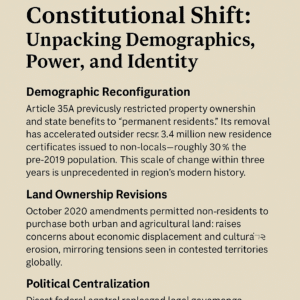Kashmir’s Constitutional Shift: Unpacking Demographics, Power, and Identity
India’s 2019 revocation of Articles 370 and 35A dismantled Jammu and Kashmir’s constitutional autonomy, splitting it into federally controlled territories. Critics argue this enables a deliberate demographic shift, evidenced by 3.4 million non-residents gaining domicile status—altering the region’s population by ~30%. New land laws now permit outsiders to own property, raising concerns about economic displacement and cultural erosion among Kashmiris. The move aligns with the ruling BJP’s Hindu-first vision, drawing comparisons to settler-colonial practices. While framed as economic integration, it has intensified political marginalization and suppressed self-determination demands. International bodies cite violations of UN resolutions and Geneva Conventions, warning of humanitarian consequences. The policy remains contentious, testing India’s commitment to pluralism amid accusations of ethno-nationalist engineering.

Kashmir’s Constitutional Shift: Unpacking Demographics, Power, and Identity
The Context:
On August 5, 2019, India revoked Articles 370 and 35A of its constitution, ending Jammu and Kashmir’s semi-autonomous status. The region was bifurcated into two federally administered territories. While framed as integration and economic progress by the ruling BJP government, critics argue this marks a deliberate demographic and political restructuring.
Key Changes and Consequences:
- Demographic Reconfiguration:
Article 35A previously restricted property ownership and state benefits to “permanent residents.” Its removal has accelerated outsider settlement. Government data (cited July 2022) reported 3.4 million new residence certificates issued to non-locals – roughly 30% of the pre-2019 population. This scale of change within three years is unprecedented in the region’s modern history.
- Land Ownership Revisions:
October 2020 amendments permitted non-residents to purchase both urban and agricultural land. For a region where land is deeply tied to identity and livelihood, this raises concerns about economic displacement and cultural erosion, mirroring tensions seen in contested territories globally.
- Political Centralization:
Direct federal control replaced local governance. Elections remain suspended indefinitely in Jammu and Kashmir, with decisions heavily influenced by New Delhi. This centralization contrasts sharply with the region’s historical governance.
Ideological Drivers and Critiques:
The move aligns with the BJP’s ideological parent (RSS) vision of a unified “Hindu Rashtra.” Critics contend that altering Kashmir’s Muslim-majority character through settlement and land laws reflects a settler-colonial pattern – using legal mechanisms to dilute indigenous political power. Parallels are drawn to historical precedents, though each context remains unique.
International Response & Legal Challenges:
Human rights organizations and the UN express concern over:
- Self-determination: Ignoring UN resolutions calling for a Kashmiri plebiscite.
- Geneva Conventions: Potential violations regarding population transfer into occupied territories.
- Cultural Preservation: Fears that demographic shifts threaten Kashmiri language, traditions, and heritage.
India dismisses these critiques as internal matters, citing security and development goals.
The Human Dimension:
Beyond geopolitics, Kashmiris face:
- Uncertain Status: Loss of special protections fuels anxiety about identity and rights.
- Economic Precarity: New competition for jobs/resources amid restricted local agency.
- Political Voicelessness: Absence of elected representatives compounds alienation.
Enduring Questions:
- Can economic development (a central government promise) coexist with demographic upheaval?
- How will land transfers impact social stability and inter-community relations?
- When will meaningful local political participation resume?
- Does international law offer recourse for perceived violations?
Why This Matters Beyond Kashmir:
This situation tests fundamental principles: How do states balance security, integration, and minority rights? When does demographic change become coercive? Can constitutional pluralism survive amid rising ethno-nationalism? Kashmir’s transformation isn’t isolated; it reflects global tensions between sovereignty, self-determination, and human rights.
You must be logged in to post a comment.